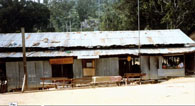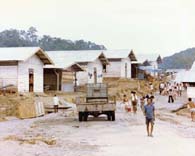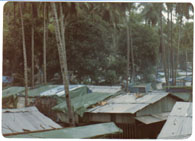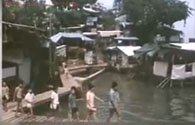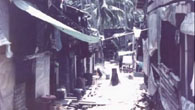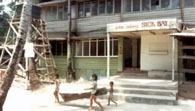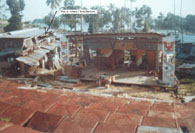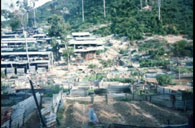|
Although this tiny island only had the capacity to accommodate for 4,500 refugees, however during some very ‘peak’ seasons, it once sheltered almost 40,000 people. To ensure the better living condition, long houses were built with schools, workshops, post office, church, temple, tailors, hair salons, bakery, noodle shops, sundry shops, even disco and bar etc. as to serve the basic needs.
Click on photos to view full size
|
|
Conditions on Bidong were difficult. One visitor, Leo Cherne, called Bidong "Hell Isle." Refugees crowded onto the island "lived in makeshift huts two and three stories high made of salvaged timbers from wrecked boats, plastic sheets, tin cans, and corrugated iron sheets." Latrines and wells were inadequate; tropical rainstorms sent rivers of filthy water through the camp; all food and clean water had to be imported from the mainland. Water was rationed at one gallon per day per person. Doctors were abundant, but medicine was in short supply. Sanitation was nearly non-existent and hepatitis was rampant. But the refugee population was well organized and many small businesses and an efficient food and water distribution system was set up. Aid organizations such as the Malaysian Red Crescent Society, the United Nations High Commissioner for Refugees and many non-governmental organizations assisted the refugees. An international volunteer staff of medical personnel tended to the refugee's health problems. Immigration officials from many countries visited the island to intervew refugees for resettlement abroad.
Food In the early years, food was scarce but eventually food was much more adequate: plenty of instant noodles, condensed milk, green bean, sugar, chicken, fish, and vegetables. In 1990, due to excessive supply of instant noodles, that were wasted, each person was given 5 packs of instant noodles per week instead of 7 packs.
Bidong had so many fishes around the island. They were also a main source of food to the refugees.
Fresh (drinking) water was always an issue, which had to be transported from mainland by boat. We called it Supplied Water. As people would stay longer for screening, this was the case for who arrived after March 14th, 1989, many wells were dug by the refugee to be used for bathe, cooking, and farming.
Refugees leaving the camp would sell their shacks to new arrivals or brokers from as little as US$20 to as high as US$400.
Black market also thrived in the community. Local fishermen traded with several Vietnamese who were brave enough to swim out to the fishing boats, anchored some distance from the island.
Entertainment In the late 80s, a musical stage was set up next to longhouse B15. There were regular music festivals performed by the refugees and Malaysian musicians as well as UN, MRCS, Police Task Force personnel. For entertainment, a weekly (musical or cultural) performance was held unless there was severe inclement weather. The Canadian Embassy provided a matching grant of RM20,000 for us to build the stage for the performances. (the MRCS matched the other half.)
|
|
Nevertheless, few structures are safe from the destructive action, such as an artificial boat besides the temple to commemorate those arrival on the island, statute of a father who pulls his beloved daughter out from the sea, cement memories with heart aching words inscribed, gravestones marking the burial plots etc. They stand like a mute reminder to the world.
|


